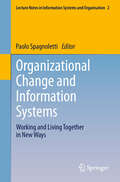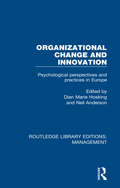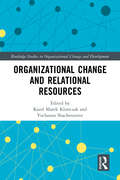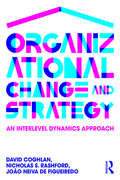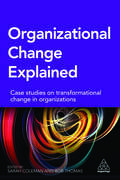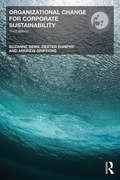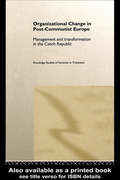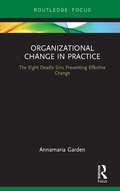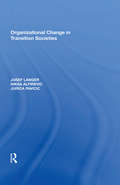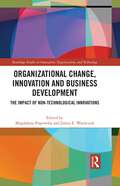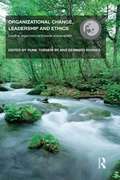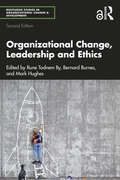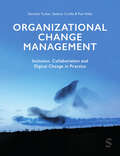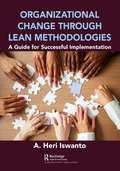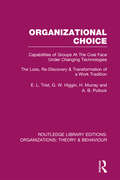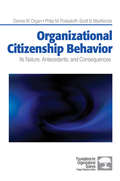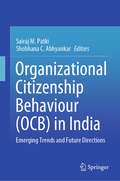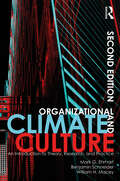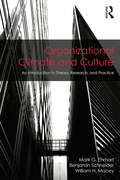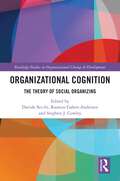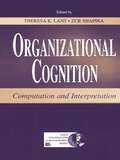- Table View
- List View
Organizational Change and Information Systems: Working and Living Together in New Ways
by Paolo SpagnolettiThis book examines a range of issues emerging from the interaction of Information Technologies and organizational systems. It contains a collection of research papers focusing on themes of growing interest in the field of Information Systems, Organization Studies, and Management. The book offers a multidisciplinary view on Information Systems aiming to disseminate academic knowledge. It might be particularly relevant to IT practitioners such as information systems managers, business managers and IT consultants. The volume is divided into six sections, each one focusing on a specific theme. The content of each section is based on a selection of the best papers (original double blind peer reviewed contributions) presented at the annual conference of the Italian chapter of AIS, which has been held in Rome, Italy in September 2012.
Organizational Change and Innovation: Psychological Perspectives and Practices in Europe (Routledge Library Editions: Management)
by Dian Marie Hosking Neil AndersonFirst published in 1992. Organisational change and innovation has been at the centre of much management literature, which has been informed by debates in organizational behaviour and strategic management. The psychology of how people in organizations adapt to and manage change is key to our understanding of the processes by which such changes can occur successfully. Organizational Change and Innovation brings together the recent research findings of leading European work and organization psychologists, who take stock of existing theories about organizational change in the light of new case material. Their findings, from a range of cultural and national contexts, challenge some previously accepted models and set a new agenda for future research. In particular, the volume provides new perspectives on the person organization relationship; the political qualities of organizational change; the input-output model of organizations as entities; and finally on research methodology.
Organizational Change and Relational Resources (Routledge Studies in Organizational Change & Development)
by Karol Marek KlimczakTransitioning organizations to the new normal following environmental shocks, economic upheavals and technological innovations is a challenge to classic organizational management, because no single organization knows with precision what the target of change is. Resources created and operated in relationships can support the organization in overcoming its constraints, changing faster, and adapting better. This book takes a relational perspective on how organizations adjust and adapt to their turbulent environment. Drawing from a broad literature and empirical studies, this book offers novel insights into how businesses create, grow, and manage relationships with partners to support strategic change. It discusses the benefits of cooperating with partners and relying on shared resources, while controlling relational risks. It presents key relational processes including organizational intelligence, open culture, knowledge sharing routines, motivation, co-creation, and communication. It discusses focus areas: longevity of family firms, improving health and safety in medical services, crisis management, public administration reforms, and relational risk management. This book is a valuable resource for researchers and students in the fields of organizational studies, organizational change, technology, and innovation management. Managers and entrepreneurs can find inspiration, motivation, and strategies for implementing and managing relationships along the value chain.
Organizational Change and Strategy: An Interlevel Dynamics Approach
by David Coghlan Nicholas S. Rashford João Neiva de FigueiredoOrganizations change, usually driven by strategies, yet strategic management and organizational change are generally understood as separate domains in the business world. This book integrates the behavioural dynamics of learning, change and strategy at and across individual, team, interdepartmental, group and organizational levels. This new edition emphasizes what can be done in organizations to enable strategy to be effective and to help organizations to change and learn. Central to the book is a reflexive engagement approach through inviting the readers to apply concepts to their own organizational situations and via reflective exercises. The authors also offer cases from a wide range of organizations, from universities to steel and digital businesses. This practical book addresses managers, consultants, students and researchers and provides specific orientation to assist each readership group to learn from its own perspective.
Organizational Change and Temporality: Bending the Arrow of Time (Routledge Studies in Organizational Change & Development)
by Patrick Dawson Christopher SykesOrganizational Change and Temporality: Bending the Arrow of Time looks to address the important area of time and temporality, especially as it relates to frameworks and studies for explaining change processes in organizations. It commences with a selective history on the science and philosophy of time before examining the place of time in work and employment, and the presence and absence of theorized time in explanations of organizational change. The intention is to bring to the fore concepts and debates that have largely remained hidden, furthering our knowledge and understanding of time and temporality in changing organizations. The authors provide a more informed theoretical explanation of the temporal dimensions of organizational change. They examine the concepts and debates behind change theories, philosophical positions and scientific concerns on time and material existence, drawing connections that have previously remained unexplored. This book is key reading for researchers within the organizational change world and will further the academic debate of time and temporality in organizations studies.
Organizational Change Explained: Case Studies on Transformational Change in Organizations
by Bob Thomas Sarah ColemanThe best way to learn how to navigate change successfully is to look at practical examples of change management programmes. Organizational Change Explained shares stories and insights from experienced change practitioners so professionals can reflect on their own work, respond critically to what others have done, and take away new tools and techniques to apply to their own change management practice. The book includes a range of cases from different sectors and countries including GlaxoSmithKline and the NHS to offer insights no matter the scale of the change management programme. Organized around central themes such as shaping and design, change leadership, and communication and engagement, Organizational Change Explained presents each case alongside an introduction, conclusion, list of key learning points, questions for reflection and sources of further reading. The book is invaluable to anyone tasked with leading or managing change within their teams, projects, departments or divisions, whether at local level or across geographic locations, countries and cultures.
Organizational Change for Corporate Sustainability
by Suzanne Benn Dexter Dunphy Andrew GriffithsSince this classic book was first published in 2003, sustainability has increasingly become mainstream business for leading corporations, whilst the topic itself has also been a hotly debated political issue across the globe. The sustainability phase models originally discussed in the book have become more relevant with ever more examples of organizations at later stages in the development of corporate sustainability. Bringing together global issues of ecological sustainability, strategic human resource management, organizational change, corporate social responsibility, leadership and community renewal, this new edition of the book further develops its unified approach to corporate sustainability and its plan of action to bring about corporate change. It integrates new research and brings illustrative case studies up to date to reflect how new approaches affect change and leadership. For the first time, a new positive model of a future sustainable world is included - strengthened by references to the global financial crisis, burgeoning world population numbers and the rise of China. With new case studies including BP's Gulf oil spill and Tokyo Electric Company's nuclear reactor disaster, this new edition will again be core reading for students and researchers of sustainability and business, organizational change and corporate social responsibility.
Organizational Change for Corporate Sustainability: A Guide For Leaders And Change Agents Of The Future (Understanding Organizational Change Ser.)
by Tim Williams Suzanne Benn Melissa EdwardsSince this classic book was first published in 2003, sustainability has increasingly been accepted as standard business practice for leading corporations, while the science itself has revealed how human activity has become the dominant force influencing irreversible changes in the planetary systems. The fourth edition of this trailblazing book on corporate sustainability provides new insights into how organizations can transition towards a more responsible way of conducting their business. It charts new thinking on value creation, business models and organizational purpose as the basis of a broader-based transition to a sustainable society. The sustainability phase model has been substantially revised to incorporate emergent approaches in sustainable supply chain management, strategic sustainability, sustainability-oriented innovation and new business models. There is a companion website that contains a range of materials to support learning. This new edition with the authors’ unified approach to sustainable business reshapes its plan of action to bring about corporate change by drawing in new management theory and practice on strategy-making and leadership, making it core reading for students and researchers of sustainability and business, organizational change and corporate social responsibility.
Organizational Change in Post-Communist Europe: Management and Transformation in the Czech Republic (Routledge Studies of Societies in Transition)
by Ed Clark Anna SoulsbyThis book provides a unique and detailed examination of the complex processes of transformation in former state-owned enterprises in the Czech Republic. Drawing on in-depth case studies of organizational transformation, the authors adopt a social-institutionalist approach to the study of organizational change, applying it in order to develop an explanation of organizational restructuring and management redefinition during the early transition period of 1990-1996. In particular, they highlight how these processes have been shaped by continuing historical state-socialist legacies and the powerful role played by senior managers in their efforts to fashion the new privatized organizations in their own interests.
Organizational Change in Practice: The Eight Deadly Sins Preventing Effective Change
by Annamaria GardenThis book challenges the practice or organizational change programmes. It uses two case studies in depth to illustrate that consulting companies can often get it wrong. Senior managers often do not know enough about managing change. The text is arranged around eight deadly sins to avoid in the practice of change: self-deception of the change agents rather than self-awareness; destruction of the identity of the organization caused by arrogance; especially of the large consulting companies; destruction of cohesion; gobbledygook language; concentrating on structural change, not behavioural change; making the organization worse, not better; the intelligence in resistance; and the deep trauma of redundancy. The author's main objective is to get academics and practitioners to stop and think about what they are doing when they work with organizations. Organizational Change in Practice will be of interest to business professionals seeking to understand how change can impact their organization as well as organizational consultants.
Organizational Change in Transition Societies (Transition And Development Ser.)
by Josef Langer Niksa Alfirevic J PavicicThis book discusses change management paradigms with special reference to examples and cases from the transition societies in Central and Eastern Europe (CEE). The first chapter analyses developments and trends in the wider societal context of Central and Eastern Europe. Theoretical perspectives are applied to understand the processes of transition and EU accession in Central and Eastern Europe. Following the second and third chapters, the most frequently used tools and procedures of change management are analysed from the perspective of a CEE organization. The special advantage of the text to the potential readership is the integration of 'macro' (societal) and 'micro' (organizational) points of view towards understanding change. The text also provides real-life examples and perspectives of understanding and managing change from Central and Eastern Europe, which helps the reader to grasp the wider political, economic and societal context(s) of the CEE region.
Organizational Change, Innovation and Business Development: The Impact of Non-Technological Innovations (Routledge Studies in Innovation, Organizations and Technology)
by Magdalena Popowska Julita E WasilczukThis volume presents a collection of different views and perspectives, featuring both theoretical and empirical contributions, to provide deep insight into the role of innovation and of non-technological innovation (NTI) in contemporary business. It illustrates how NTI encourages organizational development as well as competitive advantage. Chapters display a variety of research methods, both qualitative and quantitative, including case studies, best practices, surveys, novel approaches to interpretations, concepts and theories. Together they contribute to a significant extension of the existing knowledge on non-technological innovations and their role in organizations. This volume highlights the effects of marketing and organizational innovation strategies on companies’ innovation and overall performance, while demonstrating that the effects of NTI may vary depending on the phase of the innovation process, and how it differs within small, medium and large enterprises from manufacturing and service industries. It explores the bidirectional relationship between technological innovation (TI) and NTI, and considers the competences needed to implement NTI. The book is written for scholars and academic professionals from a wide variety of disciplines addressing issues of organizational change and innovation, new management techniques and strategies, and the sustainable growth of organizations. It may also be an interesting source of knowledge for graduate and postgraduate students in management.
Organizational Change, Innovation and Business Development: The Impact of Non-Technological Innovations (Routledge Studies in Innovation, Organizations and Technology)
by Magdalena Popowska Julita E WasilczukThis volume presents a collection of different views and perspectives, featuring both theoretical and empirical contributions, to provide deep insight into the role of innovation and of non-technological innovation (NTI) in contemporary business. It illustrates how NTI encourages organizational development as well as competitive advantage.Chapters display a variety of research methods, both qualitative and quantitative, including case studies, best practices, surveys, novel approaches to interpretations, concepts and theories. Together they contribute to a significant extension of the existing knowledge on non-technological innovations and their role in organizations. This volume highlights the effects of marketing and organizational innovation strategies on companies’ innovation and overall performance, while demonstrating that the effects of NTI may vary depending on the phase of the innovation process, and how it differs within small, medium and large enterprises from manufacturing and service industries. It explores the bidirectional relationship between technological innovation (TI) and NTI, and considers the competences needed to implement NTI.The book is written for scholars and academic professionals from a wide variety of disciplines addressing issues of organizational change and innovation, new management techniques and strategies, and the sustainable growth of organizations. It may also be an interesting source of knowledge for graduate and postgraduate students in management.
Organizational Change, Leadership and Ethics: Leading Organizations towards Sustainability (Routledge Studies in Organizational Change & Development)
by Rune Todnem By Bernard BurnesGiven recent financial crises and scandals, the rise of corporate social responsibility and the challenge of environmental sustainability, few would disagree that the role of ethics has taken centre stage in the management of organizations. In reality, however, organizations have found it extremely difficult to promote successful, ethical behaviour as this rarely results in short-term gains which can be appraised and rewarded. By and Burnes bring together leading international scholars in the fields of organizational change and leadership to explore and understand the context, theory and successful promotion of ethical behaviour in organizations. By focusing on real world examples, contributors analyze the issues and challenges that hinder ethical change leadership which can lead to sustainable organizations. This unique volume brings together the worlds of organizational change, leadership, business ethics and corporate social responsibility, resulting in a book that will be valuable reading in all four fields. With contributions from leading scholars, including David Boje, Dexter Dunphy, Suzanne Benn and Carl Rhodes, Organizational Change, Leadership and Ethics is a must-read.
Organizational Change, Leadership and Ethics: Leading Organizations Towards Sustainability (Routledge Studies in Organizational Change & Development)
by Rune Todnem By Bernard Burnes Mark HughesOrganizations and societies are facing extreme challenges that require action (IPCC, 2021). The UN's sustainability goals, demographic change, and the green shift are knocking on the door, while traditional education, and ways of leading and managing this development, often fail to keep up. Organizational Change, Leadership and Ethics challenges leadership orthodoxy, assumptions, and myths currently preventing the further development of theory and practice. It encourages intelligent disobedience in support of greater leadership capabilities and capacity in organisations and societies. As such, the book is written for everyone who wants to be MAD – to Make A Difference - students, scholars, and practitioners alike.
Organizational Change Management: Inclusion, Collaboration and Digital Change in Practice
by Danielle A Tucker Stefano Cirella Paul R KellyThis book offers a holistic introduction to Organizational Change Management through a distinct and timely perspective of organizational change agency. It takes a highly practical and unique approach, with cutting-edge chapters on digital transformation, creativity, power and inclusivity and diversity. Key features include: Case Studies based on real companies, which can be used to study chapter topics across a variety of international contexts, industries, and organizational forms. Experiential and Discussion Activities which provide an opportunity to gain invaluable insight needed in the workplace.
Organizational Change Management: Inclusion, Collaboration and Digital Change in Practice
by Danielle A Tucker Stefano Cirella Paul R KellyThis book offers a holistic introduction to Organizational Change Management through a distinct and timely perspective of organizational change agency. It takes a highly practical and unique approach, with cutting-edge chapters on digital transformation, creativity, power and inclusivity and diversity. Key features include: Case Studies based on real companies, which can be used to study chapter topics across a variety of international contexts, industries, and organizational forms. Experiential and Discussion Activities which provide an opportunity to gain invaluable insight needed in the workplace.
Organizational Change through Lean Methodologies: A Guide for Successful Implementation
by A. Heri IswantoLean is a type of organizational change brought about through improvement methods based on cost reduction mechanism. The assumption is that by reducing costs, the organizations can work better and more efficiently. All changes in lean-based organizations are directed at reducing these costs by identifying and eliminating waste. The thinking is that cost reduction will increase efficiency since, basically, it removes process inefficiencies and decreases cycle time. Why are targets directed at cost reduction? Because costs are a crucial factor for sustainable business organization. Lean thinking cuts the value of scale production by looking at the existing waste in a process. Production remains the same, but the costs of goods production are reduced due to the elimination of waste in the process. As a result, companies do not have to increase their production if it is not required, giving companies an increase in average profits due to lean and the elimination of identified waste. The focus on cost reduction can be included in the overall lean concept since cost wasting is only a part of the existing waste. In other words, other waste can be converted into costs or perceived as a value. This book starts the mental process of organization change through lean thinking. It provides the background and history of lean, and then gets into how the lean process works. The author also discusses why an organization should implement lean as a method to increase quality and engage workers in the process, thereby increasing efficiency and, ultimately, profitability. Through case studies and examples from Indonesia, the author describes how to create a value stream to identify waste and discusses the concept of a pull system and its impact on the process.
Organizational Choice: Capabilities of Groups at the Coal Face Under Changing Technologies (Routledge Library Editions: Organizations)
by E. L. Trist G. W. Higgin H. Murray A. B. PollockThis book develops and applies a new approach to the study of the working group and indeed of productive enterprises more generally. Unlike similar studies, in this volume the human is related back to the technological, and it is the socio-technical system as a whole that is the object of study. The work reported in this book shows how alternative modes of work organization can exist for the same technology, giving the possibility of organizational choice.
Organizational Citizenship Behavior: Its Nature, Antecedents, and Consequences
by Dennis W. Organ Philip M. Podsakoff Scott Bradley MacKenzieOrganizational Citizenship Behavior: Its Nature, Antecedents, and Consequences examines the vast amount of work that has been done on organizational citizenship behavior (OCB) in recent years as it has increasingly evoked interest among researchers in organizational psychology. No doubt some of this interest can be attributed to the long-held intuitive sense that job satisfaction matters. Authors Dennis W. Organ, Philip M. Podsakoff, and Scott B. MacKenzie offer conceptual insight as they build upon the various works that have been done on the subject and seek to update the record about OCB.
Organizational Citizenship Behaviour (OCB) in India: Emerging Trends and Future Directions
by Sairaj M. Patki Shobhana C. AbhyankarThis book presents an exploration of Organizational Citizenship Behaviour (OCB), a concept with a long-standing history. It offers contemporary studies and discusses possible future directions for workplaces. The diverse range of topics this book covers makes it an engaging resource for anyone interested in OCB. The section on the pandemic covers citizenship acts performed by Indian organizations, OCB among teachers, and its significant work-related correlates in post-pandemic India. The second section covers contemporary correlates of OCB, such as work-life balance, compliance, counter-productive workplace behaviours (CWBs), and employee expectations. The future workplaces section discusses challenges to OCB, the measurement of OCB in evolving work environments, the role of machine learning (ML) in recruitment, and the importance of diversity management in ensuring OCB in inclusive workplaces. The book makes a valuable source of relevant issues on OCB while providing a broader perspective on future possibilities. It serves as reference material for students and researchers in fields like organizational behaviour, human resource management and development, and industrial psychology to study contemporary issues in OCB. The book also serves as a handy guide for managers looking to harness the benefits of citizenship behaviours to give their organizations an edge over competitors in the near future.
Organizational Climate and Culture: An Introduction to Theory, Research, and Practice
by null Mark G. Ehrhart null Benjamin Schneider null William H. MaceyOrganizational Climate and Culture breaks down the barriers between the fields of organizational climate and organizational culture to encourage a broader understanding of how an organization’s environment affects its functioning and performance.Building on in-depth reviews of the development of both the organizational climate and organizational culture literatures, the book identifies key research issues as well as how practitioners can utilize the key concepts when conducting organizational cultural inquiries and leading change efforts. The book identifies the key strengths and limitations of research and theory on each topic and then presents ways each field could learn from the other. The authors also identify how practitioners can leverage the key concepts in the two literatures when conducting organizational cultural inquiries leading to climate and culture change efforts. The end product is an in-depth discussion and reconciliation of organizational climate and culture unlike anything that has come before it.In this updated edition, Mark G. Ehrhart, Benjamin Schneider and William H. Macey present a thorough examination of both the history and current status of research in each field, as well as areas for their potential integration. Academics, practitioners, and students will all deepen their understanding of how organizations function and will gain insights into how to improve both organizational research and organizational effectiveness.
Organizational Climate and Culture: An Introduction to Theory, Research, and Practice (Organization and Management Series)
by William H. Macey Benjamin Schneider Mark G. EhrhartThe fields of organizational climate and organizational culture have co-existed for several decades with very little integration between the two. In Organizational Climate and Culture: An Introduction to Theory, Research, and Practice, Mark G. Ehrhart, Benjamin Schneider, and William H. Macey break down the barriers between these fields to encourage a broader understanding of how an organization’s environment affects its functioning and performance. Building on in-depth reviews of the development of both the organizational climate and organizational culture literatures, the authors identify the key issues that researchers in each field could learn from the other and provide recommendations for the integration of the two. They also identify how practitioners can utilize the key concepts in the two literatures when conducting organizational cultural inquiries and leading change efforts. The end product is an in-depth discussion of organizational climate and culture unlike anything that has come before that provides unique insights for a broad audience of academics, practitioners, and students.
Organizational Cognition: The Theory of Social Organizing (Routledge Studies in Organizational Change & Development)
by Davide SecchiCognition is usually associated with brain activity. Undoubtedly, some brain activity is necessary for it to function. However, the last thirty years have revolutionized the way we intend and think about cognition. These developments allow us to think of cognition as distributed in the sense that it needs tools, artifacts, objects, and other external entities to allow the brain to operate properly. Organizational Cognition: The Theory of Social Organizing takes this perspective and applies it to the organization by introducing a model that defines the elements that allow cognition to work. This model shows that cognition needs the combined and simultaneous presence of micro aspects—i.e. the biological individual—and macro super-structural elements—e.g. organizational climate, culture, norms, values, rules. These two become practice of cognition as they materialize in a meso domain—this is any action that allows individuals to perform their daily duties. Due to the micro-meso-macro interactions, this has been called the 3M Model. Most of what happens in the meso domain relates to exchanges between two or more people, i.e. it is a social activity. This is usually mentioned in the perspectives above, but it is rarely explored. By bringing meso activities to the center of cognition, the book develops and presents the Theory of Social Organizing. Not only this is useful to organizational scholars, but it also opens a new path for cognition research.
Organizational Cognition: Computation and Interpretation (Organization and Management Series)
by Theresa K. Lant Zur ShapiraOrganizational Cognition is a collection of chapters written by scholars from around the world. The editors outline the history of two approaches to the study of cognition in organizations, the computational approach and the interpretive approach. The chapters represent some of the most cutting-edge research on organizational cognition, covering research that spans many levels of analysis. Much of the work in the book demonstrates how computational and interpretive approaches can be combined in a way that provides greater insight into cognitive processes in and among organizations. The editors conclude by elaborating the likely boundary conditions of each approach and how they can be combined for a more complete understanding of cognition in organizations.
